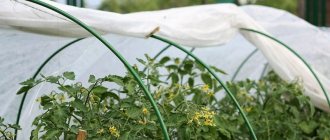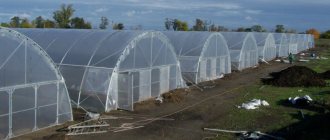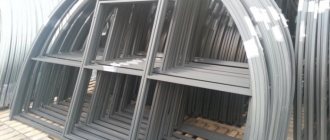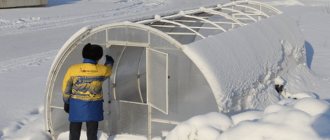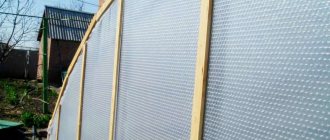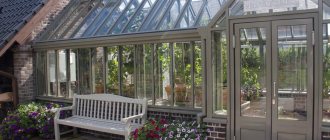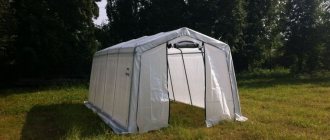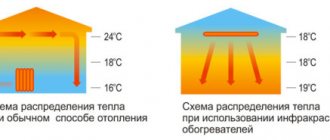A greenhouse on a summer cottage makes it possible to plant seedlings a couple of weeks earlier and get the first vegetables. The most important condition for this is to ensure normal soil temperature. For example, for tomato seedlings, it should warm up to +20°C during the day, and at night it should be maintained at a level not lower than +18°C. Special heating devices will help the summer resident to organize and maintain such conditions. The editors of the “Yanashla” website offer gardeners a review of “The best heaters for a greenhouse for 2022,” compiled according to customer opinions and expert assessments.
Optimal choice of heating system
Recently, greenhouse semicarbonate has become increasingly popular, which automatically eliminates the need for constructing a gable-type structure.
- If we consider this option taking into account reliability, we can see that it is in such a building that the strip foundation is best preserved.
- Thanks to concreting around the entire perimeter, it becomes possible to maintain optimal temperature conditions regardless of what the weather is like outside.
Based on this, it should be noted that only an arched greenhouse with sheathing made of cellular polycarbonate sheets acts as the most acceptable option in all respects.
But, before giving preference to this option, you need to pay attention to the main advantages and disadvantages.
Additional accessories
When choosing a quartz heater for the first time, you don’t immediately understand what additional accessories you may need for it, and whether they are needed at all. The Warmer House employees recommend that summer residents purchase a thermostat for greenhouse use. This measure will protect the plants from overheating and eliminate the need for constant monitoring of the device.
The following are also purchased as auxiliary accessories:
- Mounting kit for fixing the device to the wall or ceiling;
- A stand, if it is necessary to maintain the mobility of the heating device;
- Decorative screen that protects the monolith from external impacts and the gardener from accidental burns;
- Izolon to increase the power of the device and reduce energy costs.
The need to purchase such accessories is determined by the design of the greenhouse, the features of its use and the individual preferences of the owner of the summer cottage.
Pros of using infrared heaters in a greenhouse
At its essence, an infrared heater is a special device that emits rays that are in a certain way reminiscent of the sun. This allows surfaces to absorb them, which in turn helps objects and surfaces absorb them.
Subsequently, heat transfer occurs. This effect is quite similar to how sunlight is reflected.
That is why it can be noted that such heaters have the following advantages:
- Relatively low power with sufficient efficiency, which helps save on electricity consumption;
- Ease of operation;
- Do not contribute to the creation of drafts;
- Provide uniform heat distribution throughout the room.
When using convective heating devices, you can pay attention to the fact that the heated air rises upward, while the cold air remains below.
The use of such devices for heating greenhouses is not effective, since the plants are located below and, accordingly, they will not have enough heat.
A positive aspect of using infrared heaters is that with their help it becomes possible to ensure uniform distribution of heated air and ensure the formation of favorable conditions for the growth and development of plants.
Also, such devices are able to neutralize the negative effects of drafts, which can also be quite dangerous for many types of plants.
Despite the existence of a significant amount of advantages, one should also not ignore the presence of a set of negative qualities.
Classification
Infrared heating devices differ in the sources of energy released, types of heating elements, installation methods and some other characteristics.
You will be interested in learning how to heat a greenhouse using wood.
Source of released energy
Today there are 3 sources of thermal energy released by heaters, according to which devices are divided into:
- electrical;
- gas;
- diesel
Heating element type
Heating elements in gas infrared heaters are:
- metal in the form of meshes, heated to high temperatures;
- ceramic in the form of tiles, which have great strength and the ability to quickly heat up to a high temperature and quickly cool down;
- metal in the form of tubes, giving a lower temperature.
We advise you to find out how to remove condensation in a greenhouse.
According to the type of heating elements, gas infrared heaters are divided into:
- light, which, causing a visible glow, heat metal mesh or ceramic tiles to temperatures above +600°C;
- dark, heating metal tubes to temperatures below +600°C.
Form
Light heaters, as a rule, have a round or rectangular shape and are not equipped with a smoke exhauster. Dark versions of these devices have an elongated shape and are equipped with a smoke exhauster that drives combustion products through a tubular heating element.
Find out how to make automatic watering in a greenhouse with your own hands.
Installation method
As mentioned above, depending on the installation method inside the greenhouse, heating devices are divided into mobile and stationary. Since gas heaters are tied to a gas supply, they are usually made stationary and mounted on the ceiling, walls, baseboards, or suspended from the ceiling.
Typically, baseboard heaters are mounted under windows, which allows them not only to perform the functions of a heating device in a greenhouse, but also to eliminate the entry of cold air from outside into the room. Suspension devices are fixed under the ceiling using special brackets and anchor bolts. Together with ceiling devices, they are most preferable for fully heating the soil in a greenhouse.
Heating temperature
Gas heaters heat up to temperatures from +400°C to over +1000°C . The required temperature directly depends on the area and height of the greenhouse. At the same time, in infrared sources, the heat flow mainly (over 60%), unlike a convector, is formed from electromagnetic radiation produced by heating elements heated from gas combustion.
We recommend reading how to make a ventilation system in a polycarbonate greenhouse.
Emission range
Wien's law explains the dependence of the heating temperature of the irradiated surface on the wavelength of electromagnetic radiation. The higher the temperature, the shorter the electromagnetic waves. In this regard, the radiation range is divided into:
- long wave;
- medium wave;
- shortwave.
Thus, short-wave radiation is used for large industrial greenhouses.
Important! The profitability of gas heaters is due to the lower price of gas compared to electricity. A 50-liter gas cylinder can provide fuel for heaters throughout the winter months.
Disadvantages of using infrared heaters in a greenhouse
One of the main disadvantages in this case is the high cost when compared with other types of heating equipment.
- Despite this, such heaters are more economical and efficient in use.
- Also, many users pay attention to the fact that such devices relatively quickly go out of tune.
- In order not to encounter such a negative phenomenon, it is extremely important to initially focus on high-quality specimens.
- To be completely confident in your choice, you must initially focus on reviews, as well as the opinions of experts.
To protect yourself as much as possible, you need to understand that when purchasing such a product you receive a receipt and a warranty card, which allows you to make a return or exchange if certain problems or malfunctions occur.
Features of a quartz heater
A quartz heating device is a small monolithic panel that operates from the mains. Heating up in a matter of minutes, the heater quickly raises the temperature in the room. The intensity of its work does not depend on such nuances as:
- Quality of thermal insulation in the room;
- Presence of drafts;
- Possible heat losses.
To heat a standard greenhouse, one device is enough, but if gardening is the real passion of the dacha owner and he has greenhouse space of more than 50 square meters. m., it may be necessary to purchase several heaters.
Is it profitable to install IR heaters in a greenhouse?
Many greenhouse owners ask a completely logical question about how profitable it is to purchase such heaters.
It should be noted that the use of this option has a high level of efficiency. It is thanks to this that plants can grow relatively quickly at any time.
Another important aspect is that they do not contribute to drying out of the air, which in turn has a beneficial effect on the condition of the plants and the possibility of their growth.
Mobile heat generators in agriculture
In small greenhouses it can be beneficial to use compact mobile heat generators of the AGRI series.
These heat generators are designed to work with a full-fledged pressurized burner, which can be liquid fuel (diesel), gas (using bottled or main gas) or universal - using waste oil, vegetable oil, diesel fuel, etc.
The use of burners for processing in agriculture can significantly reduce the cost of production.
| Heat generators Tecnoclima AGRI Convenient for organizing temporary heating of easily assembled greenhouses or premises for livestock and poultry during the cold season. They can easily move on their own wheels, which allows them to be stored in a separate room. | Air flow, m3/hour | Consumption power, kWt | Supply voltage, V/f | |
| Agri-C 60 | 53 | 4500 | 0,40 | 220/1f |
| Agri-C 85 | 75 | 6000 | 0,53 | 220/1f |
| Agri-C 120 | 105 | 8500 | 1,00 | 220/1f |
| Agri-C 175 | 153 | 13000 | 1,35 | 380/3f |
| Agri-C 240 | 209 | 16000 | 2,20 | 380/3f |
Read more about the Tecnoclima brand...
Order us a calculation of your heat generator:
How to choose an infrared heater for a greenhouse
Considering that recently the number of people involved in the development of greenhouses has been constantly increasing, it is necessary to pay attention to the most common criteria that you need to pay attention to when choosing.
In particular, the most common options now include:
- Film and ceiling heaters.
- Cable.
- Oil based heaters.
- Gas options.
Each variety is characterized by a number of features, in particular, the amount of energy consumption.
When comparing infrared heaters with other varieties, it should be noted that the uniqueness of this option lies in the fact that they help to heat not the air in the greenhouse itself, but the plants that fall into the radiation zone.
Thus, thanks to the installation of infrared heaters, it becomes possible to provide comfortable conditions for plants, which will ensure their rapid germination.
Another important aspect is that such study creates the basis for the destruction of microorganisms and bacteria, which has a positive effect on plant growth.
Useful tips
For small drops in temperature and short-term frosts, which can be observed at night in the off-season, you can use the following techniques and primitive homemade heating devices:
- You can make a primitive heater from a candle. Place a candle placed in a tin can of stewed meat in an iron bucket with holes on the sides, pour sunflower oil into it and cover with a lid. The candle should be well strengthened - placed on a self-tapping screw. This candle will burn for a long time.
- Place buckets of coal around the greenhouse and place bricks under them.
- Another option is from a kerosene lamp and a bucket. Place two bricks on the sides of a lit kerosene lamp and place an iron bucket on them.
To heat protected soil, savvy gardeners sometimes organize joint heating of a bathhouse and a greenhouse. A greenhouse structure attached to your home will also help reduce heating costs. From such a glazed structure you can make a greenhouse or winter garden. Only such buildings should be planned before building a bathhouse or installing heating systems.
Did you know? The usual heating system for buildings, which we still use today, was invented by the English engineer Evelyn back in 1675. He used it to heat the greenhouse.
Heating the greenhouse will allow you to obtain larger yields, extend the warm period for the crops grown, and also protect against freezing in the off-season. Now there are many varieties of heaters and heating systems for greenhouses. In addition, you can make a heating device yourself.

